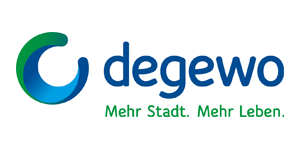degewo netzWerk GmbH
As a subsidiary of degewo AG, degewo netzWerk GmbH is the largest municipal housing company of Berlin with its 75,000 homes and 1,200 commercial units and is active in the business domains of energy management, energy supply, metering services and digital infrastructure.
Short description of the project contribution
Power-to-Heat installation as backup and ‘degewo House of the Future’ with Plus Energy concept
In the scope of WindNODE, degewo netzWerk GmbH contributes two projects:
- In Berlin-Lankwitz, degewo netzWerk GmbH owns and operates a heat generating unit for a building with 47 residential units constructed in 2016. The unit uses wood pellets for fuel. To increase the security of supply of heating energy and drinking water, the plan is to use the Power-to-Heat (PtH) unit as a backup solution if the pellet boiler is down. The PtH solution should be realised in multiple steps (up to 4 x 12.5kW planned). A suitable control concept, which has to be brought in line with the objectives of WindNODE and SINTEG, should also guarantee grid and system support in addition to the primary objective of the backup solution. In addition, it has to be worked out whether and under which circumstances the energy supply via the PtH unit is to be preferred both ecologically and economically to the heat supply with wood pellets and how this would be realised in the control concept.
- The possibilitys with climate-friendly, energy-efficient living are experienced every day by tenants in the degewo House of the Future in Havensteinstraße 20/22. degewo netzWerk GmbH owns and operates the energy generating units in the degewo House of the Future, a building from the 50s with 64 residential units. For this house in the form of a pilot solution, degewo developed a Plus Energy concept. The house in the Berlin district Lankwitz was modernised by degewo to the highest standards. Today, the house supplies itself almost entirely with climate-friendly energy from photovoltaic on the roof and facade, as well as combination modules for PV and solar thermal energy. The heat is stored seasonally in an underground storage tank and brought to a usable level via heat pumps. The electricity generated is temporarily stored in a power storage (redox-flow) for the evening and night hours. The heat demand of the apartments decreases by up to 85%. A big advantage of this is the independence of rising electricity prices.
In the 8.4 workstream ’Comparison and transfer of city district concepts’, both projects provide sufficient points of comparison for the solutions and concepts developed in WindNODE, in particular for the use of city districts to support the grid and for the assessment of possible contributions by city districts for the integration of renewable energy.
